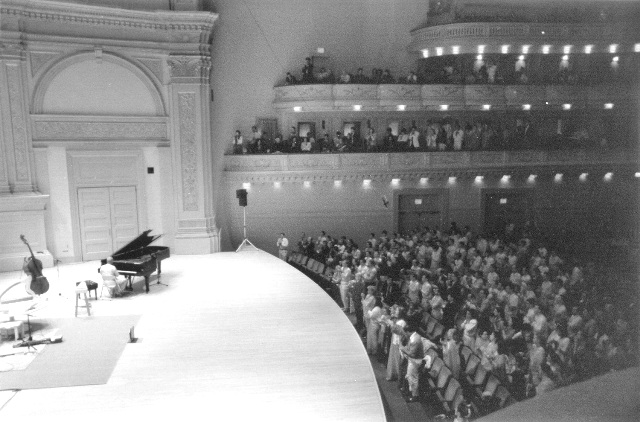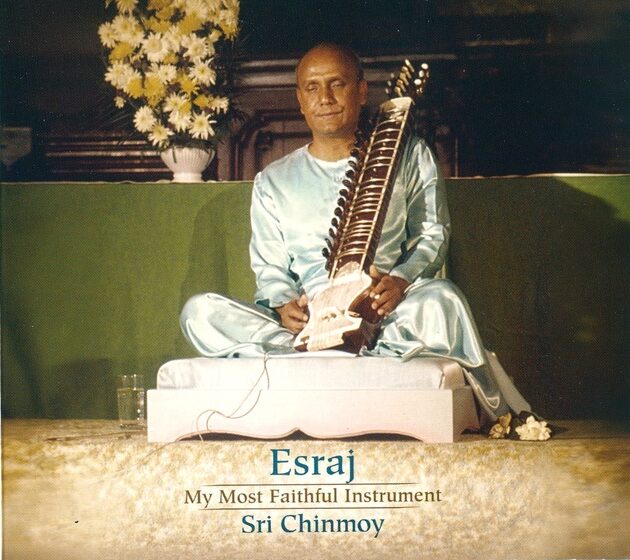Chinmoy Kumar Ghose was born in a village of East Bengal, 1931, to an affectionate and spiritually inclined family. Orphaned at age 12, he joined his siblings at the Sri Aurobindo Ashram, Pondicherry. Throughout the following 20 years in South India, he spent many hours a day in deep prayer and meditation, from which he received many profound experiences. These formative years bore a spring of creativity; though outwardly occupied in simple work, and developing as a notable sportsman, young Chinmoy’s inner silence began to reveal prolific songs and poems.
Acting on a direction from his meditation, Sri Chinmoy moved to New York in 1964, to share his inner wealth with the Western world. He began with a small number of students, giving individual tuition, as well as public lectures, on what has become known as “The Path of The Heart.” These teachings aim to remind the sincere seeker that truth, joy, and wisdom reside within; with a simple, pure and cheerful approach to life, alongside regular mediation on the heart, one can re-discover this inner birthright, and thus weave it into everyday life.
From his his arrival in America in 1964 to his passing in 2007, age 76, Sri Chinmoy travelled extensively, giving public musical performances, lectures, and meditations. He was warmly received around the globe, by such figures as Mikhael Gorbachev, Nelson Mandela, and Mother Theresa. He held weekly meditations at the United Nations, from 1970 to 2007.
warmly received around the globe, by such figures as Mikhael Gorbachev, Nelson Mandela, and Mother Theresa. He held weekly meditations at the United Nations, from 1970 to 2007.
Sri Chinmoy Centres have now developed all over the world, offering free meditation courses, concerts and exhibitions, and hosting sporting events. Amongst these is the longest foot race in the world – 3,100 miles – staged annually in New York, and the Sri Chinmoy Oneness-Home Peace Run– a global torch relay. In the field of sport, as in life itself, Sri Chinmoy’s motto is “self-transcendence” – the bettering of one’s own achievements, and striving beyond one’s perceived limitations. Even in his 70s, Sri Chinmoy was constantly seeking new goals and different outlets for his creativity, so as to inspire others to do the same. The youthful athlete became a renowned weight-lifter, lifting 256 lbs using his wrist.
Peace Concerts
From the piccolo to the pipe organ, Sri Chinmoy offered over 700 Peace Concerts at the Royal Albert Hall, the Sydney Opera House, the Great Wall of China, and myriad locations in between.
During Sri Chinmoy’s performances, he entered into a meditative state, thereby intensifying the spiritual qualities of the composition. Audience members were too invited to join in the experience by also entering into a quiet and peaceful or meditative state. In an ideal performance, the musician and the audience become one through the unifying element of the music.
Although his aim is to create meditative music, some of Sri Chinmoy’s performances on keyboard instruments also express tremendous power and dynamism, especially the organ, piano and synthesizer. Years in the West have led Sri Chinmoy to blend Eastern and Western modes into a unique style distinctly his own. Critics frequently term his music “haunting”, and this quality is enhanced by his use of the Indian esraj. Somewhat similar to the Western cello, the esraj has resonating sympathetic strings, which cause the notes to echo and re-echo long after they are bowed. Sri Chinmoy also performs on concert flute, to which he has added an electronic echo. This creates the same type of resonating sound that is innately present in the esraj. When Sri Chinmoy sings, he accompanies himself on the harmonium, a miniature Indian organ. On occasion, he also performs on the cello and harpsichord.
During his Ashram days Sri Chinmoy received singing lessons from a musical teacher, which helped him to train his voice. However, most instruments he plays are self-taught; Sri Chinmoy preferred an intuitive approach which enabled him to compose music from the heart.
His music has been broadly praised by composers and musicians such as Leonard Bernstein and David Gilbert of the New York Philharmonia.
“It is my pleasure and honor to write you these words of admiration for your astonishing achievements. You are a miraculous model of the abundance in the creative life that we lesser mortals seek, and I can only hope that I may some day meet you and perhaps participate in that cosmic fountain of stillness and profound energy which you inhabit.”
– Leonard Bernstein (in letter October, 1997)
Several records albums and tape recordings of his works have been released, including, “Music for Meditation” by Folkways Records. Other recordings are for example “Silence Speaks” or “Songs of the Soul”.
In addition to his musical legacy, Sri Chinmoy wrote over 18,000 songs and published over 1,540 books of his writings, in the hope of being of service and inspiration to others.
Related



